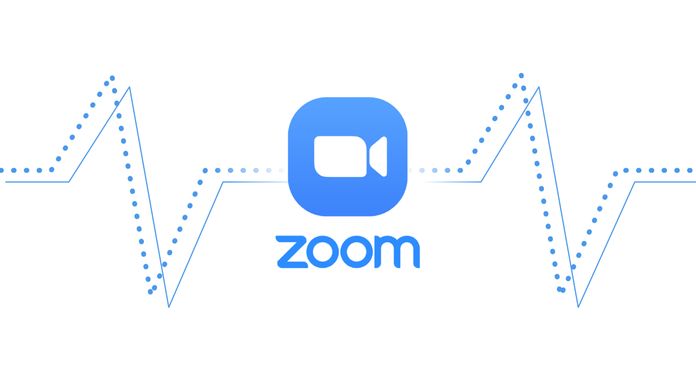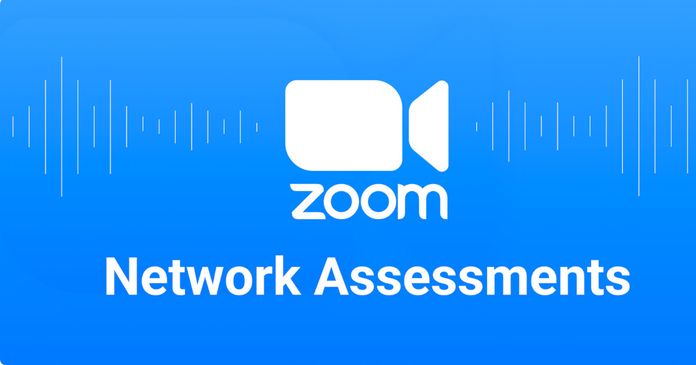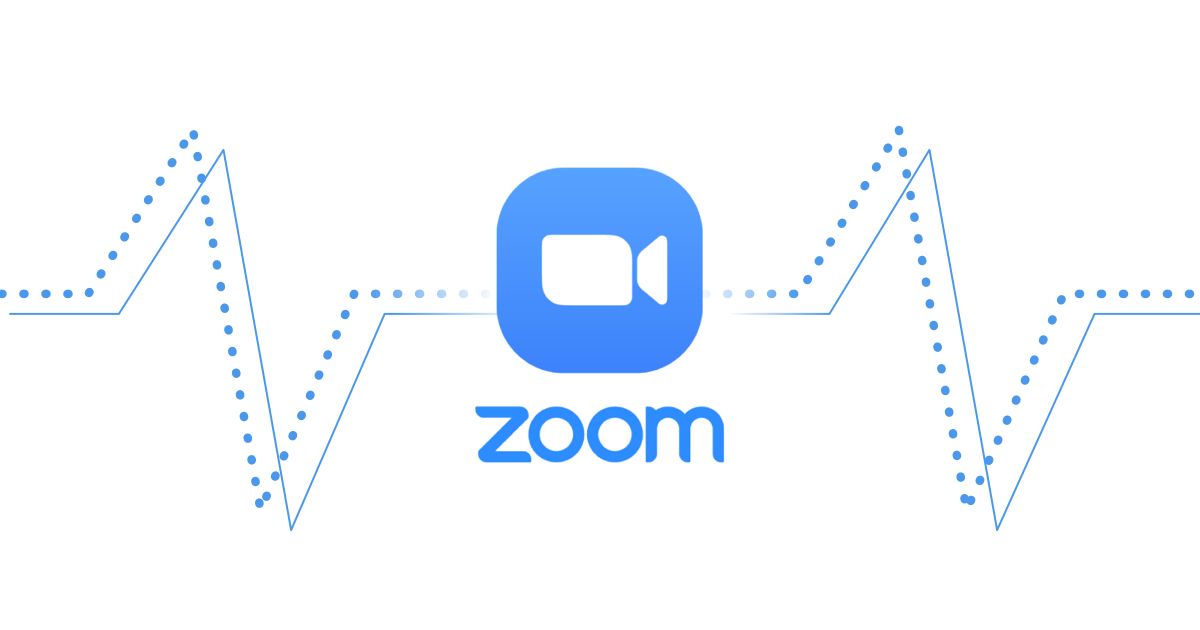Table of Contents
Table of Contents
In an era of remote work and virtual meetings, Zoom has emerged as a lifeline, connecting people across distances and facilitating seamless collaboration. However, like any technological tool, it's not without its fair share of challenges. From occasional performance hiccups to frustrating connection issues, navigating the world of Zoom can sometimes be a daunting task.
Whether you're an IT pro trying to improve your business' Zoom user experience or a professional looking to optimize your virtual meetings, understanding the underlying causes of these problems and learning effective solutions will enable you to reclaim control over your Zoom experience.
In this comprehensive guide to Zoom Troubleshooting, we'll delve into the various factors that can affect Zoom's performance and connection stability and teach you how to use Network Monitoring tools to troubleshoot common Zoom performance and connection issues.
When it comes to Zoom's performance and connection stability, network performance plays a crucial role. Zoom performance and connection issues can be caused by common network problems like jitter, packet loss and congestion. Which is why Network Monitoring is your biggest ally when monitoring Zoom performance and identifying connectivity issues.
Several factors related to network performance can impact your Zoom experience. Let's explore some of the key aspects to consider:
Internet Bandwidth: Insufficient internet bandwidth is one of the primary culprits behind poor Zoom performance. Both upload and download speeds influence your ability to send and receive audio and video data smoothly. If your internet connection is slow or shared with multiple devices, it can lead to pixelated video, audio distortion, or even dropped calls.
Network Congestion: Network congestion occurs when multiple users or devices compete for limited bandwidth simultaneously. During peak hours or in crowded networks, such as public Wi-Fi hotspots, network congestion can severely impact your Zoom connection. This can manifest as lag, jitter, or frozen video frames.
Firewall and Proxy Settings: Sometimes, the settings on your firewall or proxy server can interfere with Zoom's connectivity. If certain ports or protocols used by Zoom are blocked, it can result in connection issues. Adjusting firewall settings or consulting with your network administrator might be necessary to ensure a stable Zoom connection.
Wi-Fi Signal Strength: The strength and stability of your Wi-Fi signal are crucial for uninterrupted Zoom meetings. Weak Wi-Fi signals, especially if you are far from the router or obstructed by walls, can lead to intermittent connectivity problems, laggy video, or audio disruptions.
Network Hardware: The quality and capabilities of your network hardware, such as routers and modems, can impact Zoom performance. Outdated or underpowered equipment might struggle to handle the demands of real-time video and audio streaming, resulting in connection drops or degraded performance.
Network Quality of Service (QoS): Some routers and network setups offer Quality of Service (QoS) settings, allowing you to prioritize certain types of traffic, such as Zoom calls, over other activities on your network. Properly configuring QoS for VoIP especially can help ensure a smoother Zoom experience by giving priority to video and audio data.
Addressing these network performance factors can significantly enhance your Zoom experience. In the upcoming sections of this blog post, we'll delve deeper into each of these aspects and provide practical tips and solutions to troubleshoot network-related issues and optimize your Zoom connection stability.
Throughout this article, we'll dive deeper into every step of the Zoom troubleshooting process. For a headstart, you can take a look at the troubleshooting flowchart:
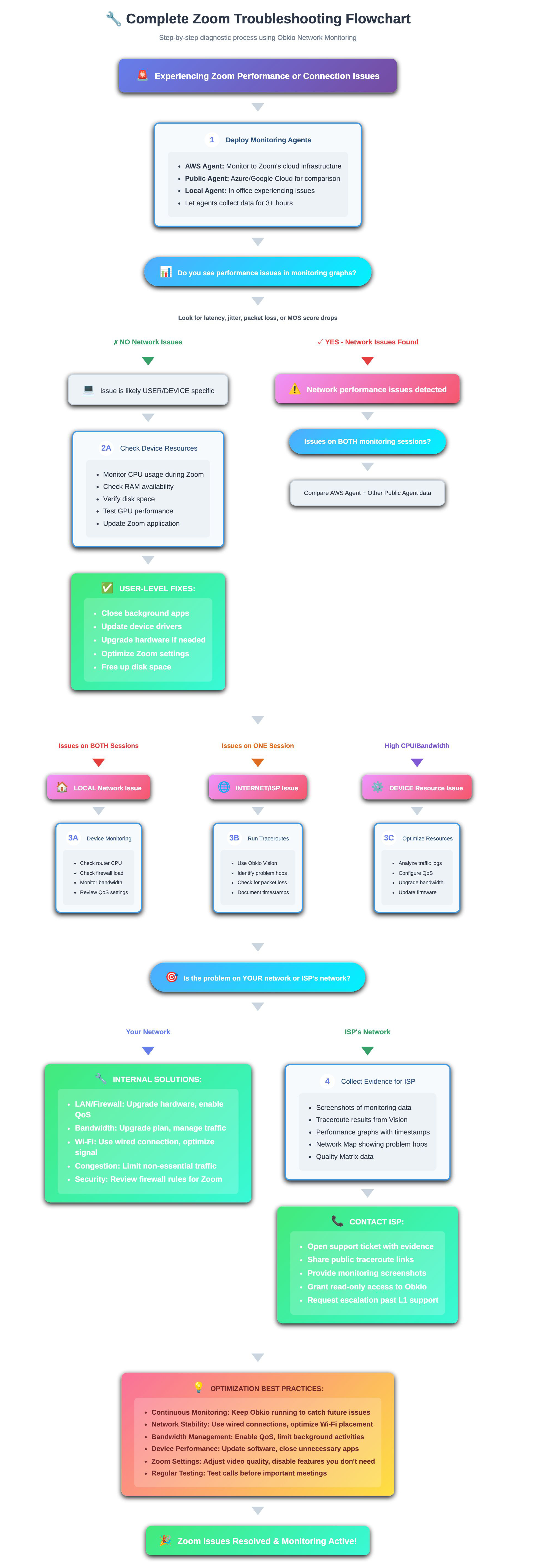
To effectively identify Zoom performance issues, it's crucial to have a reliable method for monitoring both your network and Zoom performance. By continuously monitoring these aspects, you can proactively detect and address potential issues before they impact your Zoom experience. We recommend Obkio's Network Performance Monitoring tool.
Obkio is designed specifically for monitoring network performance and can be instrumental in identifying and diagnosing network-related problems that affect Zoom performance. It provides comprehensive insights into the performance of your network infrastructure, including latency, packet loss, and bandwidth utilization.
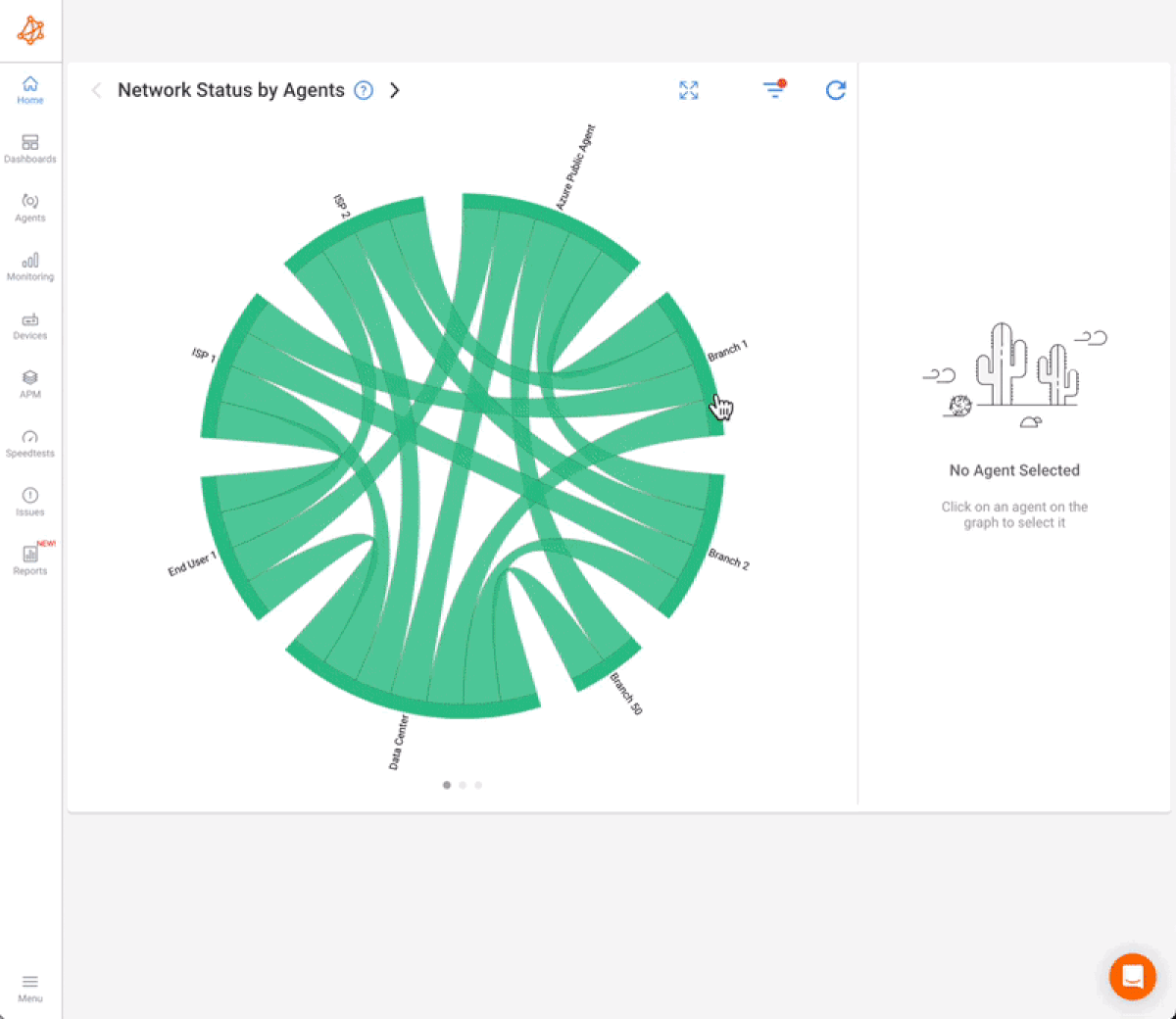
Additionally, Obkio's end-to-end monitoring ensures that you can monitor Zoom performance from the user perspective. It captures data from both ends of the connection, including your network infrastructure and the Zoom application itself. This holistic view allows you to determine whether performance issues originate from your network or Zoom's servers, enabling you to troubleshoot effectively and engage with relevant support teams, if necessary.

To begin monitoring Zoom network performance with Obkio, you need to deploy Monitoring Agents which continuously measure network and Zoom performance in key network locations.
In our previous article in our Zoom series, How to Monitor Network and Zoom Performance, we talk about setting up the Monitoring Agents, so you can refer to that article for setup.
Essentially, to collect the data you need to translate, you’ll need:
- 1 AWS Monitoring Agent: Since Zoom is supported by AWS, you’ll need the AWS Agent which monitors performance up to the AWS cloud. To learn how to find the AWS Data Center location used by your Zoom, check out our article on How to Identify the Zoom Data Center Location on AWS Infrastructure.
- 1 other Public Monitoring Agent: To compare performance up to the Internet and quickly identify if the problem is global or specific to Zoom. This will be great information for later in the troubleshooting process. You can use an Azure Agent or Google Cloud Agent.
- 1 Local Agent: Installed in the targeted office location experiencing the Zoom connectivity issues. There are several Agent types available (all with the same features), and they can be installed on MacOS, Windows, Linux and more.
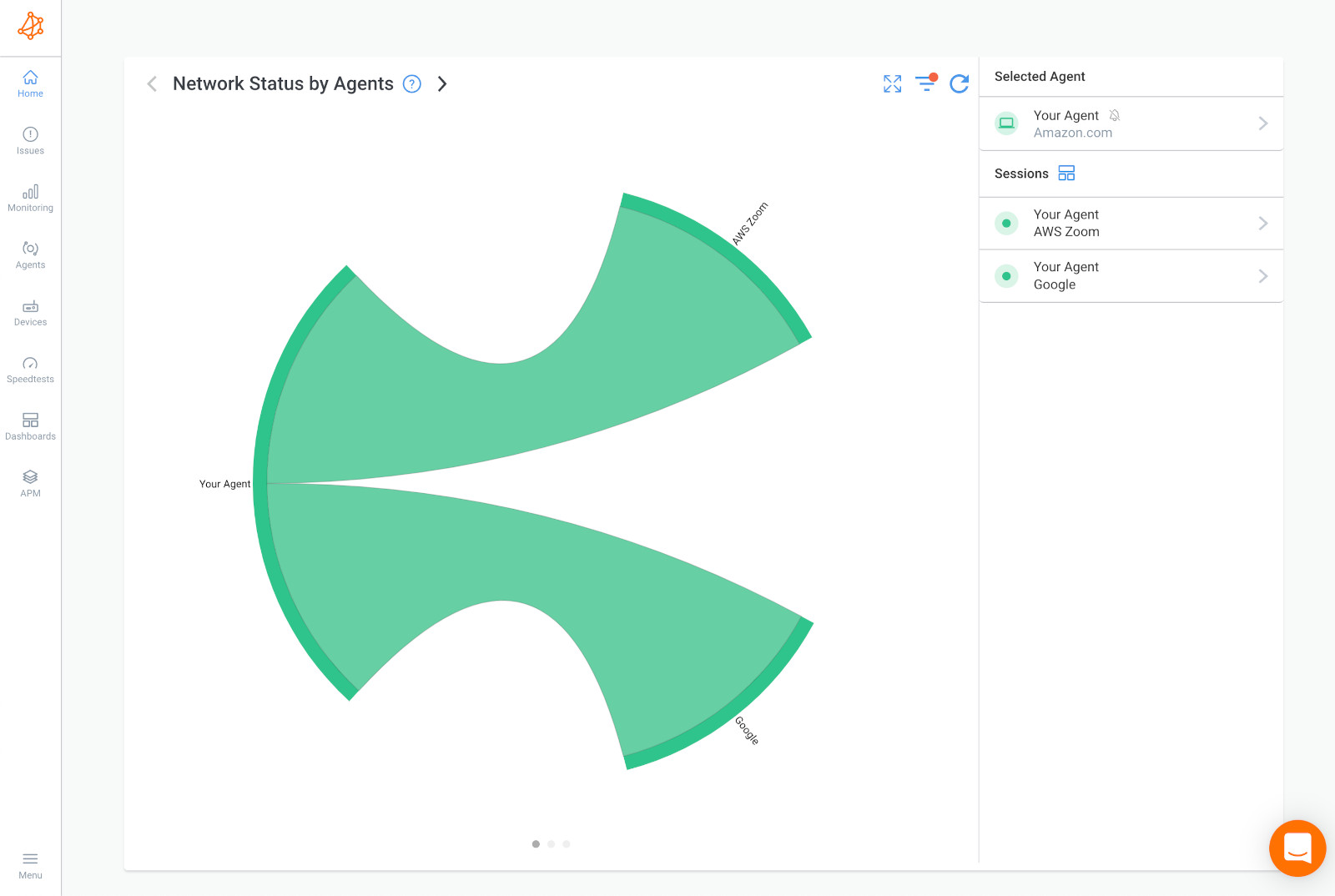
Once your Monitoring Agents are deployed, they will continuously exchange synthetic UDP traffic between each other to monitor performance, this is called a Network Monitoring Session.
To identify Zoom issues, you’ll want to let the Agents run and collect data for some time. If you’re unlucky enough, you’ll see the performance issues after just a few minutes, but we recommend letting the Agents collect data for at least 3 hours.
 Obkio's Network Response Time Graph and VoIP Quality Graph showing Latency, Jitter, and Packet Loss
Obkio's Network Response Time Graph and VoIP Quality Graph showing Latency, Jitter, and Packet Loss
When the Agents start exchanging traffic, they start monitoring and collecting performance data, which you can see on the Network Response Time Graph, such as:
- Latency: Latency refers to the time it takes for data to travel from the sender to the receiver. In Zoom, high latency can cause delays in audio and video synchronization, leading to a poor user experience. It is measured in milliseconds (ms), and lower latency values are desirable.
- Jitter: Jitter is the variation in the delay of packet arrival caused by network congestion, improper queuing, or other factors. In Zoom, high jitter can cause audio and video distortion, making it difficult to understand and follow the conversation. Jitter is measured in milliseconds (ms), and lower jitter values are better.
- Packet loss: Packet loss occurs when data packets are dropped or fail to reach their destination. In Zoom, packet loss can result in choppy audio or video, pixelation, or frozen screens. It is expressed as a percentage, and lower packet loss rates are preferred.
- VoIP Quality with MOS Score: VoIP Quality: VoIP (Voice over Internet Protocol) quality specifically focuses on the audio aspect of Zoom performance. It assesses the clarity, consistency, and reliability of voice communication during a video conference. Factors such as background noise, echo, distortion, and dropped audio packets can affect the overall VoIP quality. VoIP monitoring metrics helps ensure that participants can communicate effectively without experiencing audio-related issues.
- Bandwidth: Bandwidth is the amount of data that can be transmitted over a network connection in a given time. In Zoom, sufficient bandwidth is necessary to support high-quality audio and video streams. Insufficient bandwidth can result in degraded audio and video quality. Bandwidth is typically measured in bits per second (bps) or kilobits per second (Kbps).
- Network Congestion: Network congestion occurs when there is a high volume of traffic on a network, leading to reduced performance. In Zoom, network congestion (including WAN or LAN congestion) can cause increased latency, packet loss, and jitter. Monitoring for signs of network congestion can help identify potential issues before they impact the user experience.
- Quality of Service (QoS): QoS refers to the ability to prioritize specific types of network traffic, such as Zoom video and audio packets, over other types of traffic. Implementing QoS mechanisms can help ensure that Zoom traffic is given priority, reducing the likelihood of performance issues.
By leveraging Obkio's monitoring capabilities, you gain real-time visibility into your network's performance, allowing you to detect any anomalies or bottlenecks that may impact your Zoom calls. Obkio collects and analyzes data, providing valuable metrics and reports to help you troubleshoot and optimize your network's performance specifically for Zoom.
At this point, if you're experiencing a Zoom performance or connectivity issue, you’ll be able to see it in Obkio's Network Response Time graphs. You can see moments of jitter, packet loss, and latency, and even the impact on MOS Score.
So we now know that poor network performance can affect Zoom performance, but what Zoom issues can it cause exactly? Let's go over some of the most common Zoom performance and connection issues that we'll be troubleshooting:
- Lag and Delay: Insufficient network bandwidth or high network congestion can cause lag and delay during Zoom meetings. This results in delays between participants' audio and video streams, making conversations disjointed and difficult to follow.
- Audio Distortion: Inadequate network performance can cause audio distortion, where voices become garbled or robotic. This can make it challenging to understand and communicate effectively during Zoom calls.
- Video Freezing and Pixelation: When your network struggles to transmit video data efficiently, you may experience frequent video freezing or pixelation. This disrupts the visual quality of the meeting, making it harder to perceive facial expressions and non-verbal cues.
- Poor Image and Video Quality: If your network is unable to provide sufficient bandwidth, Zoom may automatically reduce the image and video quality to compensate. This can result in blurry or pixelated visuals, making it difficult to view shared screens or presentations.
- Inconsistent Screen Sharing: Network issues can also affect screen sharing capabilities in Zoom. Participants may encounter difficulties in sharing their screens or experience lag and delays when viewing shared content, hampering collaboration and productivity.


- Dropped Calls: Unstable network connections can lead to frequent call drops, where participants get disconnected from the meeting unexpectedly. This interruption can disrupt the flow of discussions and cause frustration for all participants.
- Limited Participant Capacity: In some cases, a weak network connection might limit the number of participants who can effectively join a Zoom meeting. If the network cannot handle the required bandwidth for multiple participants, it may result in connectivity issues or degraded performance.
These issues can significantly impact the effectiveness and productivity of your Zoom meetings. By addressing network performance problems and implementing appropriate solutions, you can mitigate these challenges and ensure a smoother and more reliable Zoom experience for yourself and all meeting participants.
Learn to monitor Zoom network performance to find Zoom jitter, Zoom packet loss & “Your Internet Connection is Unstable” Zoom performance issues on calls.
Learn more

Smooth Zoom meetings are the backbone of virtual teamwork, but pesky technical glitches can throw a wrench into the works. Don't sweat it, though—Obkio's got your back with notifications for any Zoom performance or connection issues
At this point, Obkio will notify you if you have Zoom performance or connection issues. In this section, we'll explore key troubleshooting tips to help you identify and resolve performance issues with Zoom, ranging from optimizing settings to addressing network-related challenges.
Here are some tips for troubleshooting Zoom performance issues:
Check System Requirements: Ensure that the devices used (computers, tablets, phones) meet Zoom's system requirements. Insufficient hardware or outdated software can lead to performance issues.
Internet Connection: Check the internet connection speed and stability. Zoom recommends a minimum of 1.5 Mbps for both upload and download speeds for a single participant in a meeting. If multiple participants are involved, higher speeds are necessary.
Network Bandwidth: If using Zoom in a business environment, make sure that network bandwidth is sufficient to handle video conferencing traffic without congestion or bottlenecks. Consider prioritizing Zoom traffic using Quality of Service (QoS) settings on routers if available.
Close Background Applications: Close unnecessary applications running in the background, especially those consuming significant CPU or bandwidth. This can free up resources for Zoom and improve performance.
Update Zoom and Drivers: Ensure that Zoom is updated to the latest version. Also, update device drivers, especially graphics and network drivers, as outdated drivers can cause compatibility issues and performance problems.
Optimize Zoom Settings: In Zoom's settings, optimize video and audio settings based on available bandwidth. Lowering video quality or disabling non-essential features like virtual backgrounds can improve performance on slower connections.
Test with Different Devices: If possible, test Zoom on different devices (e.g., desktop, laptop, mobile) and networks to isolate whether the issue is device-specific or network-related.
Check Firewall and Antivirus Settings: Ensure that firewall and antivirus settings are not blocking Zoom traffic. Configure them to allow Zoom connections and prioritize Zoom traffic if necessary.
Use Wired Connection: Whenever possible, use a wired Ethernet connection instead of Wi-Fi, as it provides more stable and reliable network connectivity, reducing the chances of performance issues.
Monitor Resource Usage: Use task manager or activity monitor to monitor resource usage (CPU, memory, network) during Zoom sessions. High resource usage may indicate underlying issues that need to be addressed.
Update Firmware and Software: Ensure that routers, switches, and other network infrastructure components have up-to-date firmware. Also, update other software on devices that could impact Zoom performance.
Test Outside Peak Hours: Conduct Zoom meetings during off-peak hours to avoid network congestion that can affect performance.
Contact Zoom Support: If troubleshooting steps don't resolve the issues, reach out to Zoom's support for further assistance. Provide them with detailed information about the problem and steps you've already taken to troubleshoot.
Smooth Zoom connections are crucial for productive virtual meetings, but technical hiccups can throw a wrench into your plans. In this section, we'll delve into specific troubleshooting tips to help you tackle Zoom connection issues head-on.
Check System Requirements:
- Ensure that your device meets Zoom's system requirements, including minimum processor speed, RAM, and supported operating systems.
- Make sure you have sufficient storage space available on your device to run Zoom smoothly.
Internet Connection:
- Run a speed test to check your internet connection's upload and download speeds. Aim for a stable connection with at least 1.5 Mbps for both upload and download speeds per participant.
- Avoid using shared or public Wi-Fi networks, as they can lead to unstable connections and poor video quality.
Network Bandwidth:
- If you're experiencing connectivity issues during group meetings, check if your network bandwidth is being consumed by other applications. Close unnecessary apps or devices using the network to free up bandwidth for Zoom.
- Consider upgrading your internet plan if you frequently experience bandwidth limitations during Zoom calls.
Close Background Applications:
- Close any background applications that might be consuming excessive CPU or network resources. This includes file-sharing programs, streaming services, or heavy browser tabs.
- Running too many applications simultaneously can lead to performance issues, including connectivity problems in Zoom.
Update Zoom and Drivers:
- Ensure that you are using the latest version of Zoom and that your device's drivers (especially graphics and network drivers) are up to date.
- Zoom regularly releases updates with performance improvements and bug fixes, so keeping your app updated is essential for optimal performance.
Optimize Zoom Settings:
- Adjust Zoom's settings to optimize performance based on your internet connection. For example, lower video quality settings or disable non-essential features like virtual backgrounds to reduce bandwidth consumption.
- Enable hardware acceleration in Zoom settings if available, as this can offload processing tasks to your device's hardware and improve performance.
Test with Different Devices:
- If possible, test Zoom on different devices (e.g., desktop, laptop, mobile) to determine if the issue is specific to a particular device or operating system.
- This can help isolate whether the problem lies with Zoom itself or with your device's configuration.
Check Firewall and Antivirus Settings:
- Ensure that your firewall or antivirus software is not blocking Zoom's connections. Add Zoom to the whitelist or allowlist of trusted applications to prevent such issues.
- Some security software may have features that can interfere with Zoom's connectivity, so review your settings accordingly.
Use Wired Connection:
- Whenever possible, use a wired Ethernet connection instead of Wi-Fi. Wired connections are generally more stable and reliable, providing a better Zoom experience with fewer connectivity issues.
Monitor Network Traffic:
- Use network monitoring tools to track and analyze network traffic during Zoom calls. Look for any spikes or congestion that could be affecting your connection quality.
- Address any network bottlenecks or issues identified through monitoring to improve overall connectivity for Zoom and other applications.
Clear and reliable audio is key to successful virtual meetings on Zoom. However, audio issues like echo, low volume, or static can disrupt communication. In this section, we'll explore practical tips for troubleshooting Zoom audio problems.
Check Audio Settings: Start by checking Zoom's audio settings. Ensure that the correct microphone and speakers/headphones are selected in Zoom's settings. Sometimes, the wrong audio devices can cause audio problems.
Test Audio Devices: Test your microphone and speakers/headphones outside of Zoom to ensure they are working correctly. You can use your device's built-in audio recorder or another communication app for this test.
Adjust Audio Levels: Check the volume levels of your microphone and speakers/headphones. Make sure they are not set too low or too high, as this can affect audio quality.
Close Background Apps: Close any background applications that might be using your audio devices. These apps can sometimes interfere with Zoom's audio functionality.
Update Zoom: Make sure you are using the latest version of Zoom. Zoom regularly releases updates with bug fixes and performance improvements, including audio-related issues.
Check Device Settings: Review your device's audio settings in the system preferences or control panel. Ensure that the microphone and speakers/headphones are enabled and configured correctly.
Use Original Audio: If you're experiencing audio quality issues, try using Zoom's "Original Sound" feature. This feature preserves the original audio quality without noise suppression or echo cancellation.
Check Network Connection: Poor network connection can also cause audio issues in Zoom. Ensure that you have a stable and reliable internet connection with sufficient bandwidth for audio calls.
Update Audio Drivers: Update your device's audio drivers to the latest version. Outdated drivers can sometimes lead to audio problems in Zoom and other applications.
Test with Different Devices: If possible, test Zoom audio on different devices to determine if the issue is specific to one device. This can help isolate whether the problem lies with Zoom or your device's audio setup.
Use Headphones: If you're experiencing echo or feedback during Zoom calls, using headphones can help prevent audio looping between your microphone and speakers.
Restart Devices: Sometimes, simply restarting your computer or mobile device can resolve audio issues by refreshing system settings and processes.
To begin troubleshooting your Zoom issue, you need to first establish: Is it really a network problem?
When encountering a Zoom issue, it's important to determine whether the problem stems from a network-related issue or if it originates from another source. To effectively troubleshoot, you can begin by comparing monitoring sessions between the AWS Public Monitoring Agent and another Public Monitoring Agent you have deployed.
- Establishing a Baseline: Start by establishing a baseline for normal network performance. Monitor the performance of both agents during typical usage periods when Zoom is functioning without any apparent issues. This baseline data serves as a reference point for comparison when troubleshooting Zoom problems later.
- Capturing Performance Data: During a Zoom session experiencing issues, capture performance data simultaneously from both monitoring agents. This data should include metrics such as latency, packet loss, and bandwidth utilization. Comparing the data collected from the AWS Public Monitoring Agent and the other Public Monitoring Agent allows you to identify discrepancies and pinpoint potential network-related problems.
- Analyzing the Data: Analyze the collected performance data to identify any patterns or anomalies that correlate with the reported Zoom issue. Look for variations in network metrics between the two monitoring agents. If there are significant differences in performance, it suggests that the network may indeed be contributing to the Zoom problem.
Obkio can also help you perform a Zoom assessment to identify issues and ensure that your network requirements are meeting those needed to support Zoom.
In the screenshot below, you’ll see an example of a Network Session with no performance issues. As a reference, this is what it looks like when the network isn’t the cause of your Zoom problem.
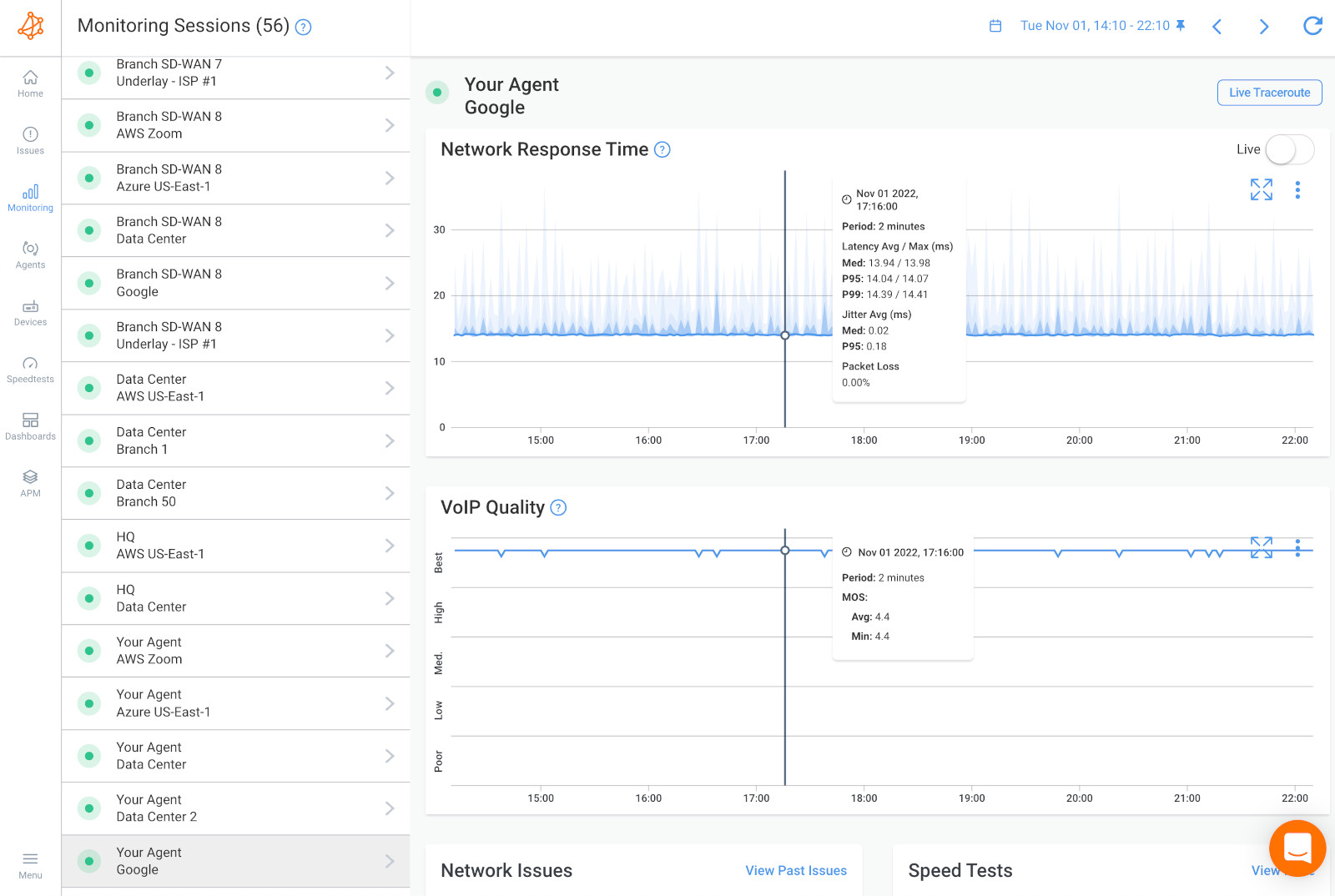
If it’s not a network issue, it might be a user issue. In this case, you can install a Monitoring Agent directly on a user’s workstation (the user who is experiencing the Zoom issues) to get a performance perspective from their point-of-view.
If you still don’t find a network problem at this point, it may just be a problem that can be solved directly on the user's workstation. Zoom, like several other hardware-intensive videoconferencing systems, uses up a lot of resources (CPU, RAM).
Luckily Obkio also monitors these important resource metrics for you!
In the screenshot below is an example of a network issue happening on both network sessions.
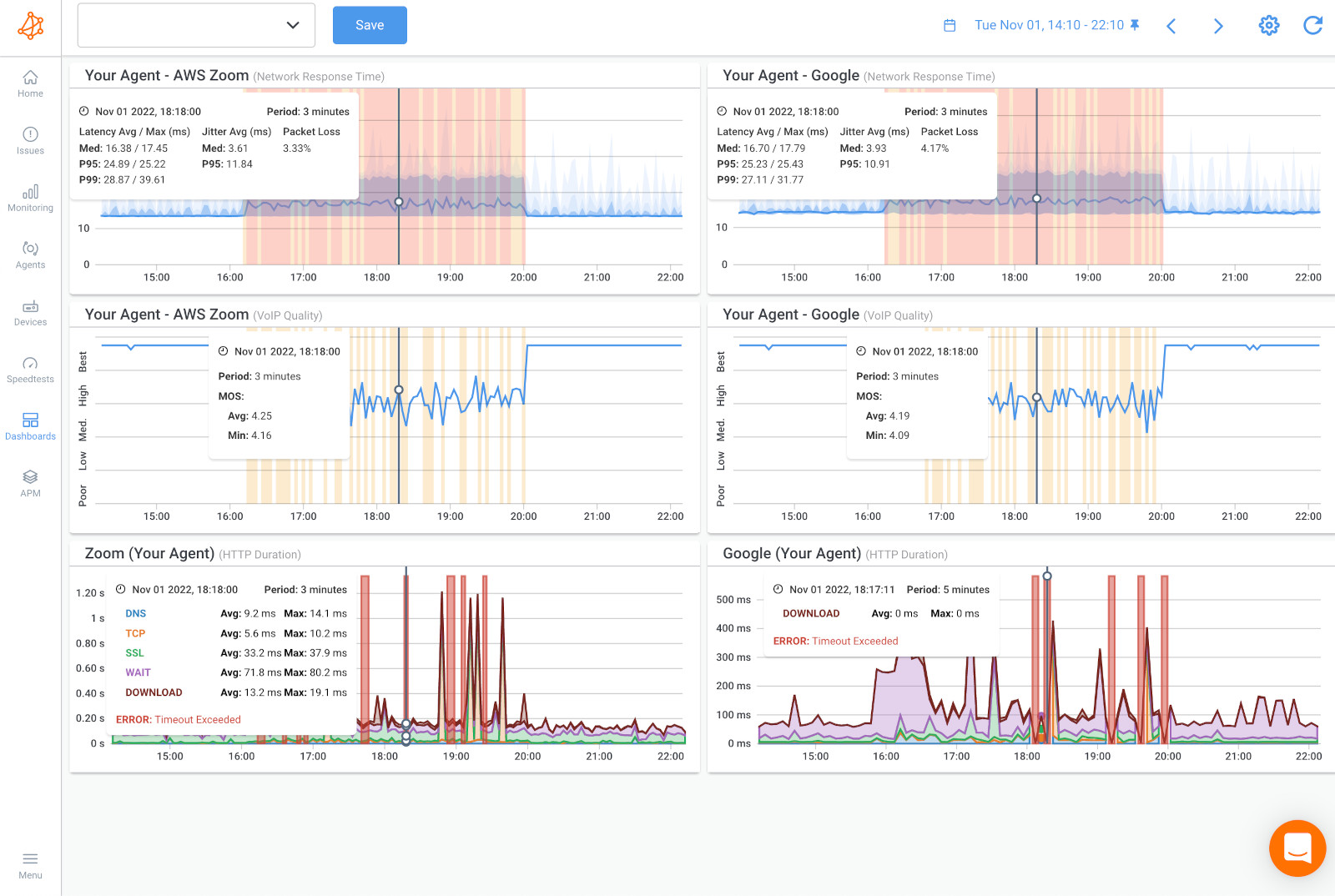
This implies that there is a broader issue within a common network segment that impacts all services and applications relying on the network. The affected network segment could be the local area network (LAN), the firewall, or even the local loop Internet connection. Let's explore this further:
- Common Network Segment: The fact that both network sessions display similar performance issues suggests that the problem lies within a network segment that is shared by both sessions. This segment could be a specific LAN, a particular subnet, or even a network segment behind a common firewall.
- Impact on All Services and Applications: Since the issue affects multiple network sessions, it implies that all services and applications utilizing that particular network segment may encounter connectivity problems or degraded performance. It is not isolated to Zoom alone but can extend to any other application or service that relies on the same network infrastructure.
- Possible Culprits: The problem's source could reside within the LAN infrastructure, such as network switches, routers, or cabling issues. Alternatively, it could be associated with the firewall configuration or the local loop Internet connection provided by the Internet Service Provider (ISP).
To address this broader network issue, you may need to investigate and analyze the affected network segment. We need to examine the LAN setup, ensuring the network devices are functioning correctly, and verifying the integrity of the network cabling. Additionally, reviewing the firewall configuration and checking for any misconfigurations or rules that could impact network traffic is essential. Finally, contacting your ISP to diagnose and resolve any potential issues with the local loop Internet connection may be necessary.
In the screenshot below is an example of a network issue happening on only one network session.
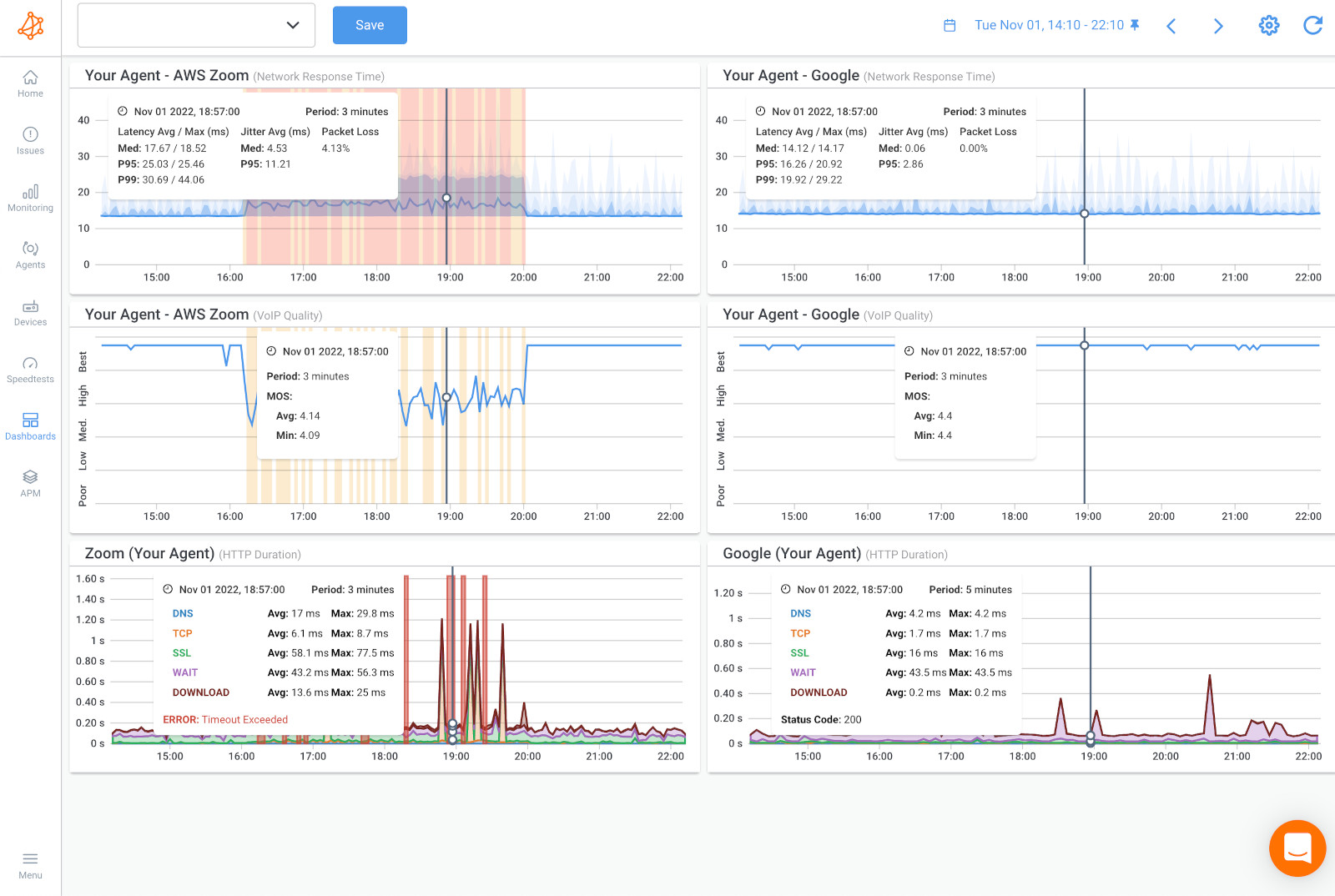
This means that the network problem is happening specifically towards that specific location on the Internet and that the problem is further away.
- Isolated Network Session: The fact that the network issue is occurring in only one network session indicates that the problem is not widespread across all services or applications. It is localized to the specific session or connection being observed.
- Location-Specific Problem: The issue suggests that the network problem is specific to the location on the Internet associated with the affected network session. This could indicate a potential issue with the network infrastructure or connectivity at that specific geographical location.
- Further Away Issue: The observation that the problem is further away implies that the issue lies beyond your local network or immediate network environment. It could be related to the Internet Service Provider (ISP), a problematic network node or link, or issues with routing and traffic management further down the network path.
To address this location-specific network problem, you may need to focus on factors beyond your direct control. In this case, skip right to Step 6.
If the network problem is happening on both network sessions, compare that data using Obkio’s Device Monitoring feature to further understand if the Zoom connectivity issue is happening on your end, or over the Internet, in your Service Provider’s network.
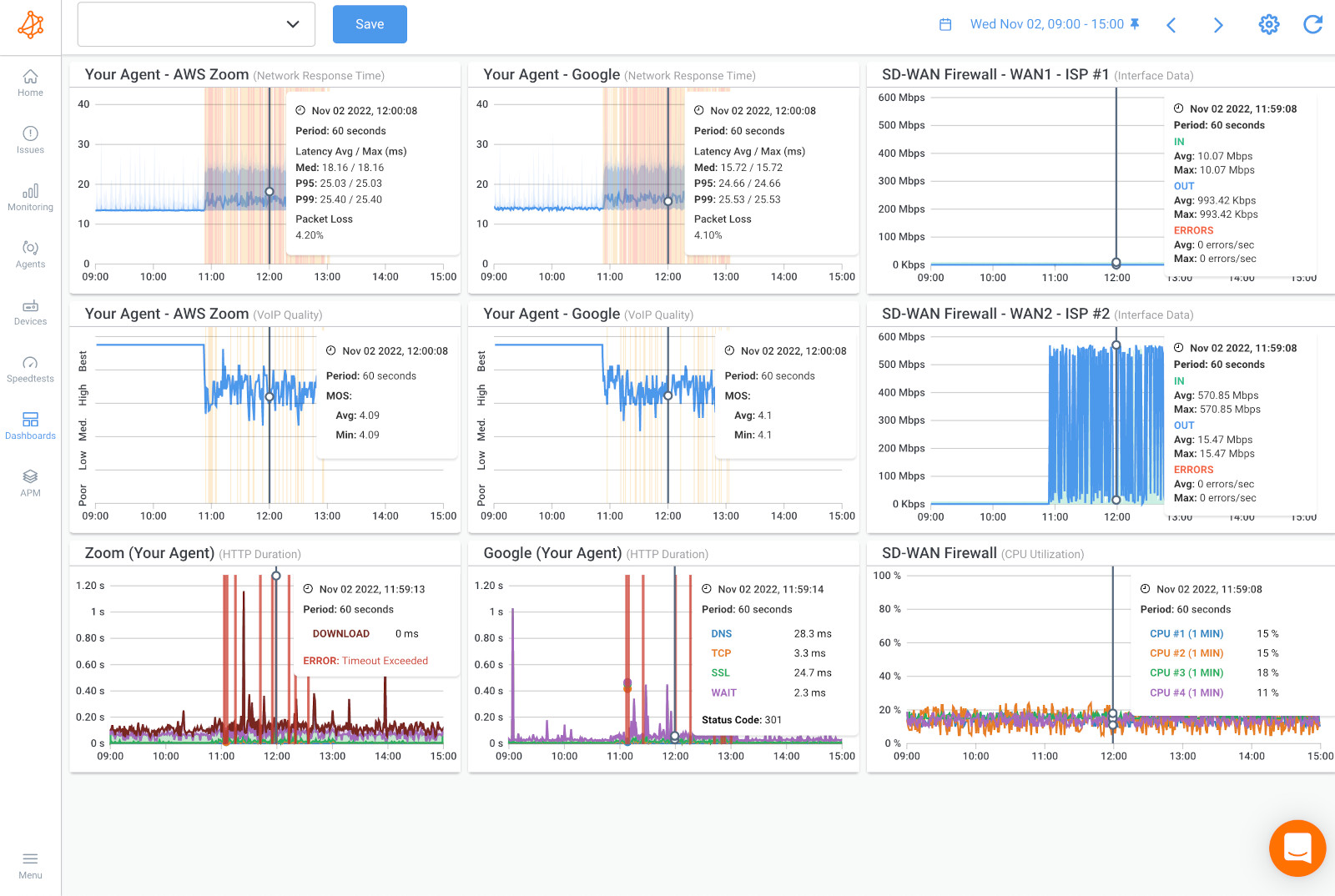

When you compare your previous data with Device Monitoring metrics, if you find CPU or Bandwidth issues, this likely means that the problem is on your end and you need to do something.
Here are a few suggestions:
- Look into what traffic is being used. Understand if the traffic is legitimate or not by looking at the firewall logs. Illegitimate traffic might be a security breach (data exfiltration), or mass data backup happening during business hours instead of during the night.
- Manage priorities in your Firewall to prioritize Zoom traffic in order to reduce the impact on Zoom during periods of congestion. This means that all the traffic towards or from Zoom will be prioritized first when passing through the network.
- Upgrade your Internet connection bandwidth with your ISP if you’re just running out of bandwidth.
- Look into your device to understand why it’s missing resources and causing high CPU usage. There may be a software problem, your device may need a firmware update, the last update may be bugged, or the device may just not have enough resources available and needs to be upgraded to a bigger device.
If you notice CPU-related metrics indicating high utilization or spikes during your Zoom sessions, it suggests that the performance bottleneck may lie within your device or computer. High CPU usage can strain system resources and affect the smooth operation of Zoom, resulting in performance issues such as lag, audio/video distortion, or freezing.
To address CPU-related issues, you can take several steps:
- Close any unnecessary applications or processes running in the background to free up system resources.
- Update your device's drivers, including graphics and audio, to ensure compatibility and optimal performance.
- If your device's hardware is outdated or insufficient, consider upgrading to a more capable system that can handle the demands of Zoom effectively.
If the comparison of your previous data and bandwidth metrics reveals low available bandwidth or excessive utilization during Zoom sessions, it suggests that your network connection may be struggling to handle the required data transfer for smooth Zoom performance. Inadequate bandwidth can result in audio/video distortion, buffering, or dropped connections.
To address bandwidth issues, there are a few steps you can take:
- Firstly, check if there are any other devices or users on your network consuming excessive bandwidth.
- Temporarily pause or limit bandwidth-intensive activities such as large file downloads or streaming on other devices during important Zoom sessions.
- Contact your Internet Service Provider (ISP) to ensure you have sufficient bandwidth for your needs and consider upgrading your plan if necessary.
- Optimizing your Wi-Fi signal strength by repositioning your router or using wired connections can also help improve bandwidth availability.
In addition to network-related issues, there are other resources that can impact Zoom performance. Here are some common Zoom resource issues:
CPU (Central Processing Unit) Usage:
If your device's CPU is heavily taxed by other resource-intensive applications or processes, it can lead to decreased performance in Zoom. High CPU usage can cause lag, audio/video issues, and overall sluggishness during Zoom meetings.
Some troubleshooting steps include:
- Close unnecessary applications running in the background to free up CPU resources.
- Prioritize Zoom by setting it to high priority in the task manager or resource manager.
- Consider upgrading your device's CPU if it is outdated or insufficient for handling Zoom's requirements.
Memory (RAM) Usage:
Insufficient available memory can impact Zoom's performance, especially when running multiple applications simultaneously. When your device's RAM is overloaded, it can result in slow response times, freezing, or crashes during Zoom sessions.
Some troubleshooting steps include:
- Close unnecessary applications to free up RAM.
- Disable or limit background processes or services that consume excessive memory.
- Upgrade your device's RAM if it is insufficient for running Zoom smoothly.
Disk Space:
Limited free disk space on your device's storage drive can affect Zoom's performance, particularly when it comes to saving and accessing files during meetings. If your disk space is low, it may cause delays or errors when sharing files, recording meetings, or accessing chat history.
Some troubleshooting steps include:
- Free up disk space by removing unnecessary files or applications from your device.
- Move large files or data to an external storage device or cloud storage to create more space.
- Regularly clean up temporary files and caches on your device.
Graphics Processing: Zoom relies on the graphics processing unit (GPU) for rendering video, screen sharing, and visual effects. If your GPU is outdated or underpowered, it can lead to video quality issues, pixelation, or choppy performance during Zoom calls.
Some troubleshooting steps include: Update your graphics drivers to the latest version compatible with your device. Adjust Zoom's video settings to a lower resolution or disable certain visual effects to reduce GPU load. Consider upgrading your GPU if it is outdated or underpowered.
Internet Bandwidth: While network performance was discussed earlier, it's worth noting that inadequate internet bandwidth can be a separate resource issue. If your internet connection lacks the necessary bandwidth to support Zoom's audio, video, and data transmission, it can result in poor call quality, lag, or dropped connections.
Some troubleshooting steps include:
- Close other bandwidth-consuming applications or devices sharing your network during important Zoom meetings.
- Connect your device directly to the router using an Ethernet cable for a more stable and faster connection.
- Contact your ISP to ensure you have sufficient bandwidth for your Zoom usage and consider upgrading your plan if needed.
Zoom Application Version:
Using an outdated version of the Zoom application can lead to compatibility issues and reduced performance. It's essential to keep your Zoom application up to date with the latest version, as updates often include bug fixes, performance enhancements, and new features.
Some troubleshooting steps include:
- Check for updates regularly and install the latest version of the Zoom application.
- Enable automatic updates to ensure you are always using the most recent version.
- Uninstall and reinstall Zoom if you encounter persistent issues with the application.
Device Configuration: Suboptimal device configurations, such as incorrect audio or video settings, outdated drivers, or incompatible hardware, can impact Zoom's performance. Ensuring that your device is properly configured and meets Zoom's recommended system requirements is crucial for optimal performance.
Some troubleshooting steps include:
- Check and adjust your device's audio and video settings within the Zoom application to ensure they are correctly configured.
- Update your device's drivers, including audio and video drivers, to the latest versions recommended by the manufacturer.
- Verify that your device meets the minimum system requirements specified by Zoom.
If you don’t see any resource issues from your devices, this is a sign that the network problem affecting your Zoom performance is on your Service Provider’s end.
In this case, you need to open a service ticket with as much information as you can collect. And, for your request to be taken seriously and be quickly escalated past 1st level support, you need to share as much information as you can. Obkio will be your best friend for that.
The data you can provide is that from your dashboard in the previous steps, as well as your Traceroutes in the next step.
Discover how to boost Zoom performance with Zoom assessments. Learn the steps & tools to understand Zoom network requirements, & identify Zoom issues.
Learn more

At this point, you can now collect the last bit of data about where exactly the network problem is located so you can share that information with your Service Provider.
- Opening a Service Ticket: Contact your ISP's customer support or technical support to initiate the process of opening a service ticket. This will allow them to investigate and resolve the network problem that is impacting your Zoom performance.
- Sharing Detailed Information: To ensure your service ticket is taken seriously and quickly escalated, it is essential to share as much information as possible. This information will help the ISP's support team understand the issue better and expedite the troubleshooting process.
The data collected from your dashboard, as mentioned in the previous steps of monitoring network performance, can be immensely valuable. Provide the relevant metrics and performance data captured during the Zoom sessions, highlighting any significant discrepancies or issues observed. This information will offer insights into the specific network conditions experienced during problematic Zoom sessions.
Traceroutes provide valuable information about the path and network nodes that data packets traverse between your device and Zoom's servers. Sharing traceroute results with your ISP allows them to identify potential network bottlenecks, routing issues, or problematic nodes that could be causing the performance problems.
To do this, we’ll be using Obkio Vision, Obkio’s free Visual Traceroute tool that runs continuously to interpret Traceroute results to identify network problems in your WAN and over the Internet.
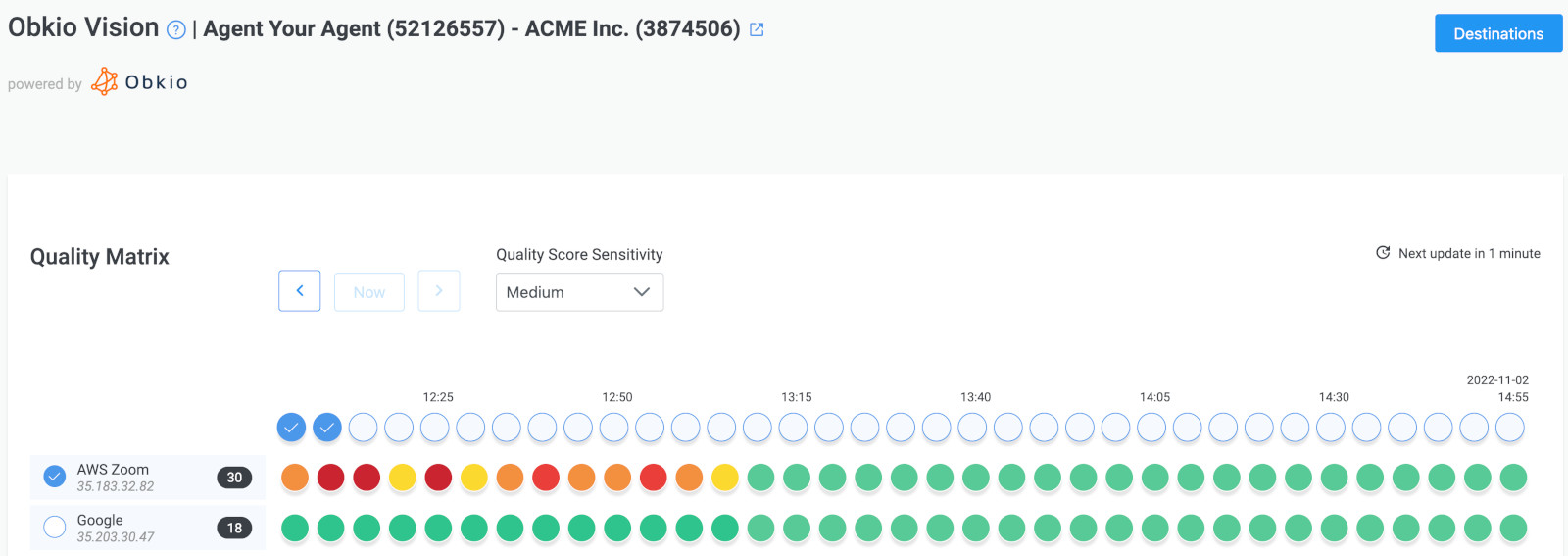 Obkio Vision Quality Matrix
Obkio Vision Quality Matrix
Note: If the network problem is happening on your end, you don’t need to do this step. It’ll just further confirm that conclusion.
By using Traceroutes, the Network Map, and the Quality Matrix you’ll be able to identify if:
- The problem is happening specifically towards a specific location over the Internet. So only one specific site is being affected.
- The problem is on your ISP’s side and you need to open a service ticket with as much information as you can collect.
 Obkio Vision Network Map
Obkio Vision Network Map
- Contact your ISP to get technical support using the screenshots of Monitoring Sessions, Dashboards or Traceroutes in Vision.
- Share results of Live Traceroutes with your ISP using a public link.
- If your ISP wants to analyze your data further, you can create a temporary Read-Only User in your Obkio account for them.
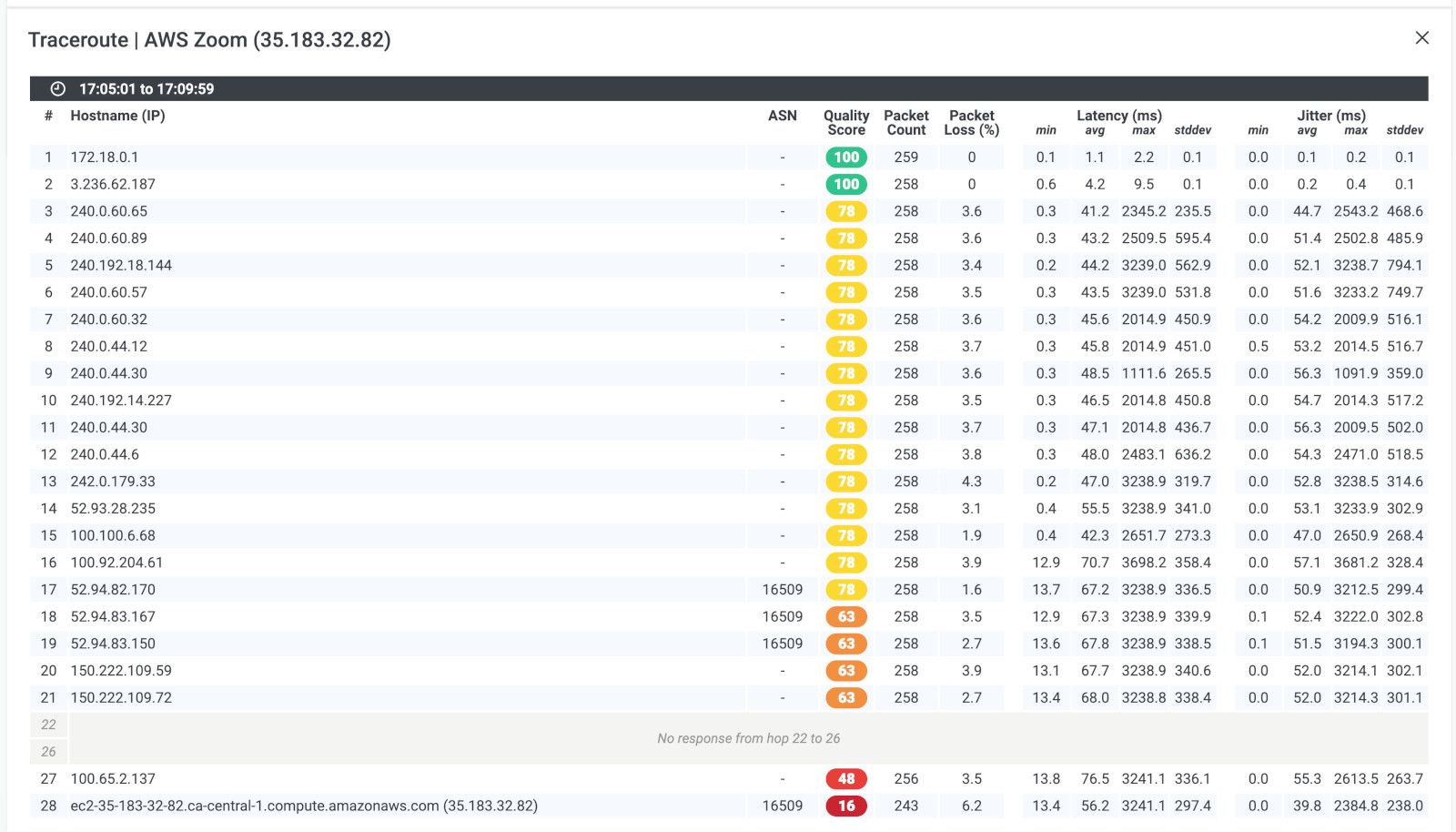 Obkio Vision Traceroutes
Obkio Vision Traceroutes
As mentioned, utilizing a network performance monitoring tool like Obkio can be beneficial in this situation. Obkio can provide additional data and insights into network performance, which you can include when communicating with your ISP. Sharing relevant graphs, statistics, and performance trends from Obkio can provide comprehensive evidence of the network issues impacting your Zoom performance.


Step into the Zoom optimization zone, where we unlock the secrets to a smoother and more delightful virtual experience! As we reach the finale of our Zoom troubleshooting journey, it's time to unleash the ultimate power-ups that will turbocharge your Zoom performance. Get ready to level up with these 10 tips for optimizing Zoom performance
After troubleshooting and identifying the factors affecting your Zoom performance, there are several techniques you can employ to optimize your Zoom experience. Here are some techniques for optimizing Zoom performance:
- Utilize network performance monitoring tools like Obkio to continuously monitor your Zoom performance.
- Monitor metrics such as network latency, packet loss, and jitter to identify any potential issues or degradation in performance.
- Set up alerts or notifications to be informed of any significant changes or abnormalities in Zoom performance.
- Stable and Reliable Network Connection:
- Position yourself closer to the Wi-Fi router to improve signal strength.
- Minimize interference from other devices by avoiding crowded Wi-Fi channels.
- Limit the number of active devices sharing your network during Zoom sessions.
- Prioritize Zoom traffic on your network by enabling Quality of Service (QoS) settings on your router.
- Pause or limit bandwidth-intensive activities, such as file downloads or streaming, during important Zoom meetings.
- Close unnecessary applications or browser tabs consuming bandwidth in the background.
- Close other applications running in the background to free up system resources.
- Update your device's operating system, graphics drivers, and other relevant software to the latest versions.
- Adjust Zoom settings for optimal performance, such as video resolution, audio settings, and screen sharing preferences.
- Disable or limit resource-intensive background processes or services on your device.
- Disable notifications or alerts from other applications that could interrupt your Zoom sessions.
- If using a virtual background, choose a static image instead of a video loop to reduce resource consumption.
- Adjust Zoom's video settings to a lower resolution if you experience lag or buffering during video calls.
- Disable unnecessary Zoom features like screen sharing, chat, or non-essential video filters.
- Consider using audio-only mode for calls when video is not necessary.
- Ensure proper lighting in your environment to enhance video quality and reduce strain on the camera.
- Position your camera at eye level for a more natural and engaging video experience.
- Keep your Zoom application updated with the latest version to benefit from bug fixes, performance improvements, and new features.
- Conduct a test call or meeting with a colleague or friend before important meetings to ensure everything is working smoothly.
By implementing these optimization techniques, you can enhance your Zoom performance and create a smoother and more reliable experience for yourself and other participants. Remember to adapt these techniques based on your specific device, network environment, and the nature of your Zoom usage.


Once you’ve collected the data you need to troubleshoot your Zoom performance and connectivity issues, you don’t have to dread your next Zoom call.
But remember, Zoom issues can always come back.
That’s why it’s important to keep monitoring Zoom performance so you can identify and troubleshoot performance issues as soon as they happen. Install Monitoring Agents in all your network locations, and keep Obkio as your permanent Zoom monitoring and troubleshooting tool!

- 14-day free trial of all premium features
- Deploy in just 10 minutes
- Monitor performance in all key network locations
- Measure real-time network metrics
- Identify and troubleshoot live network problems













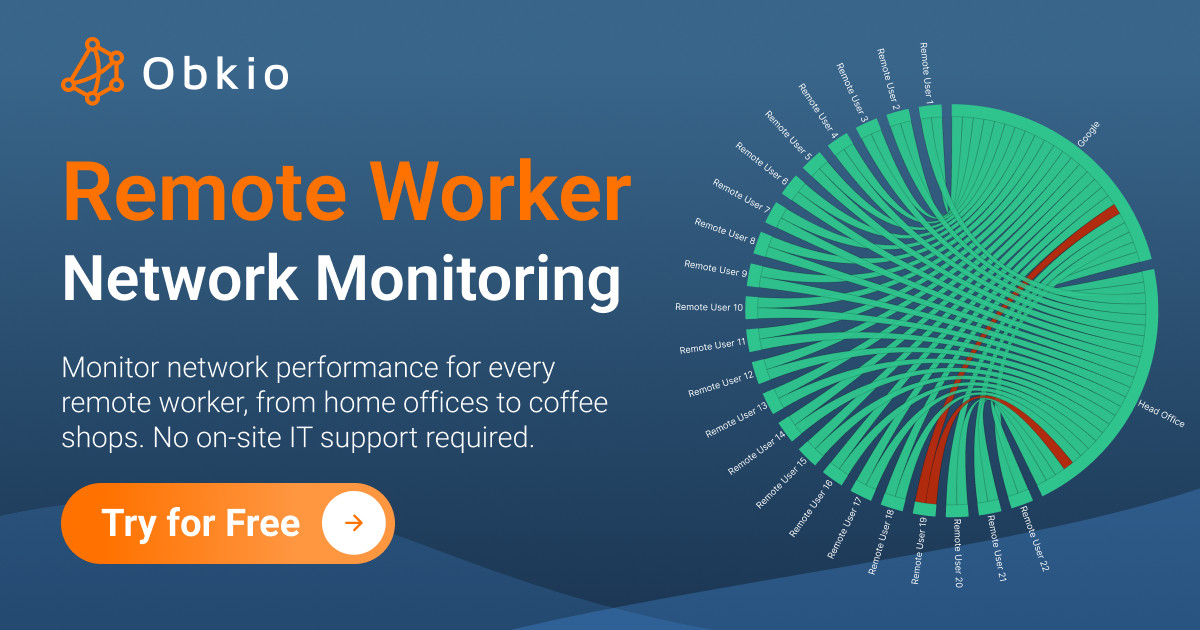













 Obkio Blog
Obkio Blog





